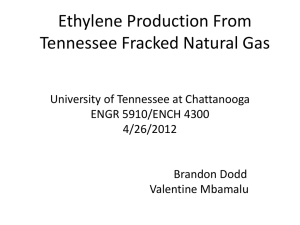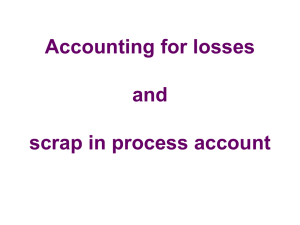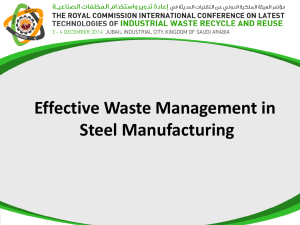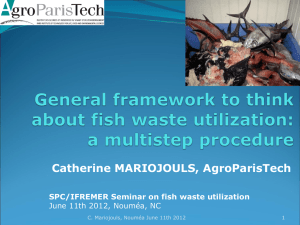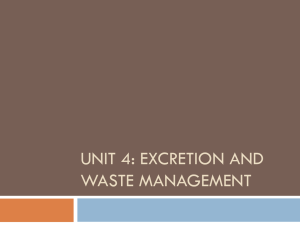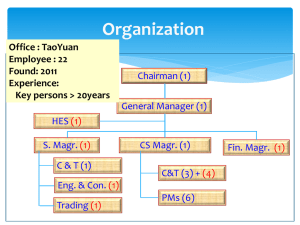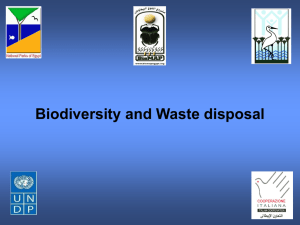The current state of Art of food processing by Products
advertisement
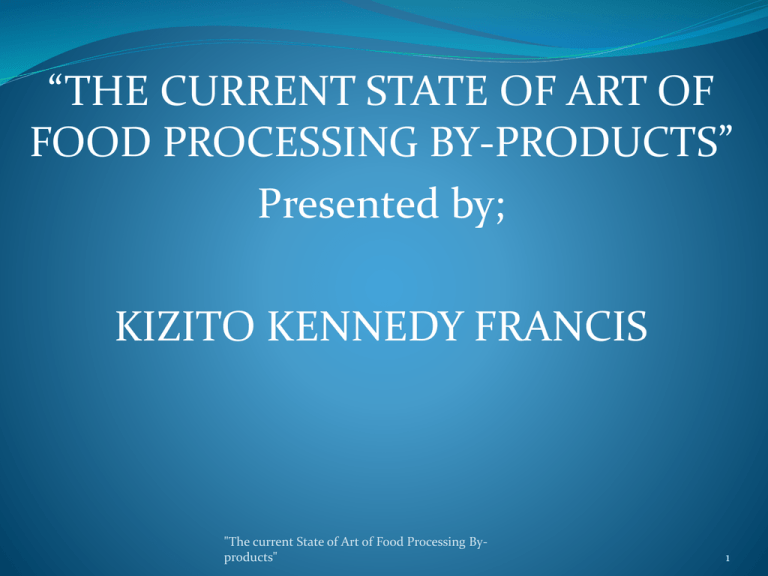
“THE CURRENT STATE OF ART OF FOOD PROCESSING BY-PRODUCTS” Presented by; KIZITO KENNEDY FRANCIS "The current State of Art of Food Processing Byproducts" 1 Contents: 1: Introduction: 2. Nature and sources of food processing wastes 3: Utilization of Animal processing wastes 4: Bio-energy production from food processing wastes. 5: Bioactive compounds from selected plant wastes. "The current State of Art of Food Processing Byproducts" 2 Introduction: Food processing wastes are increasing being considered as valuable resource. About 45 billion kg of fresh fruits, vegetable, milk, grain products are lost as waste in USA, annually. 20 million tons of food waste in UK annually. EPA estimates 1$ billion as cost of waste disposal. Every ton of food waste is equivalent to 4.5 tons of CO2 emissions. (environmental pollution) "The current State of Art of Food Processing Byproducts" 3 PRODUCTION PROCESS % OF WASTE AND BY-PRODUCTS Beef slaughtering 40-50 Corn starch production 41-43 Crustaceans processing 50-60 Fish canning 30-65 Fish filleting, curing, salting and smoking 50-75 Fresh, soft and cheese production 85-90 Fruit and vegetable processing and preservation 5-30 Milk butter and cream production Negligible Mollusk processing 20-50 Pig slaughtering 35 Potato starch production 80 Poultry slaughtering 31-38 Red wine production 20-30 Sugar production from beet 86 Vegetable oil production 40-70 Wheat starch production 50 White wine production Yoghurt production 20-30 "The current State of Art of Food Processing By2-6 products" 4 "The current State of Art of Food Processing Byproducts" 5 FOOD TYPE: PROCESSED FOOD: "The current State of Art of Food Processing Byproducts" RESIDUE TYPE: 6 FOOD TYPE: PROCESSED FOOD: "The current State of Art of Food Processing Byproducts" RESIDUE TYPE: 7 Solid food wastes (organic and inorganic) main source: Raw materials ~ Organic solid waste: ~ Inorganic solid waste: Liquid food processing wastes.(Effluents) main source: water used "The current State of Art of Food Processing Byproducts" 8 "The current State of Art of Food Processing Byproducts" 9 "The current State of Art of Food Processing Byproducts" 10 Therefore, SSF is certainly a good way of utilizing nutrient rich solid wastes as a substrate. Both food and agricultural wastes are produced in huge amounts and since they are rich in carbohydrates and other nutrients, they can serve as a substrate for the production of bulk 11 "The current State of Art of Food Processing Byproducts" 12 Utilization of by-products of animal, poultry and fish processing: Nature of by products. Profitability of processing of these by-products USDAERS: United States Department of Agriculture Economic Research Service *11.4% gross income of beef *7.5% gross income of pork Pollution "The current State of Art of Food Processing Byproducts" 13 Nutritive value of edible meat by-products: Amino acids: Vitamins Vitamin content in relation to RDA per 100 g serving of Liver from beef or pork contributes: Nutrient (RDA) % RDA per 100g serving of the liver Vitamin A 0.9 mg 450-1100 Vitamin B6 1.7 mg 65 Vitamin B12 0.0024 mg 3700 Ascorbic acid 90 mg 37 Minerals: mineral composition in mg/per 100g of body organ Mineral and source Composition (mg/100g Manganese (liver) 0.128-0.344 Copper (liver) 1.8-7 Phosphorous (thymus) 393-558 Potassium (thymus) 360-433 Calcium (mechanically deboned meat) 315-485 "The current State of Art of Food Processing Byproducts" 14 Utilization of Blood: Blood is 63% Plasma. Use of blood in food: Emulsifier Stabilizer for vaccines Clarifier Color additive "The current State of Art of Food Processing Byproducts" 15 Skins and Hides: Treatments: Air drying, curing with salt, curing by mixer and raceway. Best quality: 40-48% moisture Gelatin from hides and skins: Hydrolysis of collagen (water insoluble) • Elimination of non collagenous raw material • Hydrolysis of collagen • Recovery and drying of final product "The current State of Art of Food Processing Byproducts" 16 • • • • • • Use of gelatin in food & pharmaceutical: Production of gelled desserts. Stabilizer for ice creams & frozen desserts. Inhibit formation of ice crystals & recrystallization of lactose. Making outer coverings of capsules Binding agent in medicated tablets Used in cosmetic products "The current State of Art of Food Processing Byproducts" 17 Utilization of Bones: Carcass % Bone composition of carcass weight Beef Pork Lamb Marrow 15 11 16 4-6 Mechanically separated meat: Used in low percentages: 5-10% in burgers and ground meat 10- 40% in sausages If used in High percentage: Flavor & quality are reduced Meat and bone meal:- Animal nutrition, fuel, phosphorous "The current State of Art of Food Processing Byfertilizer products" 18 Utilization of Glands and organs: "The current State of Art of Food Processing Byproducts" 19 Medicinal & pharmaceutical values: o CNS is a source of cholesterol: *For synthesis of vitamin D3. *Emulsifier in cosmetics o Bile extract: For treatment of ingestion, constipation & bile tract disorders. o Liver: a source of nutritional supplements (Vit. B12) o Heparin: From liver, lungs & small intestinal lining. Used as blood anticoagulant o Hormones from ovaries: *Progesterone & estrogen: treatment of reproductive problems. *Relaxin: used during child birth "The current State of Art of Food Processing Byproducts" 20 o Hormones from the pancreas: *Insulin: regulates sugar metabolism. (Diabetes) *Glucagon: increase blood sugar, treats insulin overdose. *Chymotrypsin and trypsin: improve healing after surgery or injury o Catgut manufacture (internal surgical sutures) "The current State of Art of Food Processing Byproducts" 21 Utilization of Lard and Tallow: Obtained by: ~dry rendering ~wet rendering (better quality) Used in deep frying (consumer health concerns) Manufacture of margarine and shortening Sausages and emulsified products "The current State of Art of Food Processing Byproducts" 22 Water waster from meat and poultry processing: Sources: scalding, feather removal, carcass washing, sanitizing equipment. Screening waste waters: separation of soft tissue Effect of waste water on environment. "The current State of Art of Food Processing Byproducts" 23 Potential uses of fish wastes "The current State of Art of Food Processing Byproducts" 24 "The current State of Art of Food Processing Byproducts" 25 Utilization of wastes as Biofuel: Biogas production: From cattle manure, piggery waste water and by products of aquaculture. "The current State of Art of Food Processing Byproducts" 26 "The current State of Art of Food Processing Byproducts" 27 Production of Biodiesel from oil and fat wastes of food processing "The current State of Art of Food Processing Byproducts" 28 "The current State of Art of Food Processing Byproducts" 29 Effluents are predominant. Solid wastes: UN 2013 report estimates about 15M tons of FVW are generated by India, China, USA and Philipines. Disposal and Environmental pollution. "The current State of Art of Food Processing Byproducts" 30 Excellent source of nutrients for livestock. Source of bioactive compounds. Useful in Bioenergy production. Artificial fertilizers. "The current State of Art of Food Processing Byproducts" 31 Examples: • Banana foliage. • Dried citrus pulp • Mango seed kernel • Pineapple juice waste • Fresh cauliflower & cabbage "The current State of Art of Food Processing Byproducts" 32 "The current State of Art of Food Processing Byproducts" 33 Example: Bioactive compounds from wastes of Citrus processing: • Sources of bioactive compounds 1: Flavedo layers (8-10% fruit weight): Source of Essential oils *used as flavorings, fragrances and solvents. 2: Albedo (white spongy) layer: (15-30% fruit weight) ~Source of pectin ~Naringin can be obtained from the rind of grapefruit. "The current State of Art of Food Processing Byproducts" 34 "The current State of Art of Food Processing Byproducts" 35 Comparing pectin yield with the various extraction methods: "The current State of Art of Food Processing Byproducts" 36 Pectin extraction: • Acid extraction • Filtration • Precipitation by alcohol. Uses of pectin: -gelling in jams & jellies, thickening, texturizing, emulsifier & stabilizer… Naringin: * Is converted to Neohesperidian dihydrochalcone:- used as non caloric artificial sweetener. (about 1000-1800 times the sweetness of sucrose solution ) "The current State of Art of Food Processing Byproducts" 37 "The current State of Art of Food Processing Byproducts" 38 Utilization of food processing wastes in the production of high value added products has increased the profitability of the food processing industry by reducing the cost of disposal of these wastes. "The current State of Art of Food Processing Byproducts" 39 THANK YOU FOR YOUR ATTENTION "The current State of Art of Food Processing Byproducts" 40
